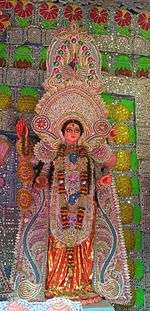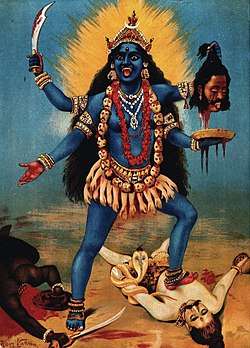Bhairavi
| Tripura Bhairavi | |
|---|---|
| Goddess of Kundalini[1] | |
 An image of Goddess Bhairavi, Lithograph Print, circa 1880s of Bengal | |
| Affiliation | Parvati, Mahavidya , Adishakti and Mahakali |
| Abode | Kailash |
| Mantra | Om Has'm Hasakar'm Has'm Bhai ,Ravi Namo Namah |
| Mount | Sunflower |
| Consort | Bhairava |
Bhairavi is a Hindu goddess associated with the Mahavidyas. She is the consort of Bhairava.[2][3]
Symbolism
.jpg)
The name Bhairavi means "Terror" or "awe-inspiring". She is the Fifth of ten Mahavidyas. She is also called Tripurabhairavi. "Tri" means three, "Pura" means fortress, castle, city, town, etc. Tripura convey three different stages of consciousness i.e active, dream and deep sleep. She is in the form of all triads and once these triads are transcended, the Brahman is attained. In other words, once we have her grace, we can realize Shiva consciousness. Hence She is called Tripurabhairavi.[4][5]
Her dhyana shloka in the Devi Mahatmya describes her form. She is seated on a lotus with four hands, one with a book, one with rosary beads, one with abhaya mudra and another with varada mundra. She wears red garments and wears a garland of severed heads around her neck. She has three eyes and her head is adorned with a crescent moon. In another form she is carrying a sword and a cup containing blood and other two hands showing abhaya and varada mudras. She is also depicted as sitting on Shiva, which is more predominant in tantric worship. She is also depicted as a queen, closely resembling Rajarajeswari.[6]
Tripurabhairavī is set to be residing in muladhara chakra. Her mantra consists of three letters and they all form an inverted triangle in the centre of muladhara chakra. She is the creator in muladhara chakra in the form of kamarupa, which consists of three dots forming an inverted triangle, from which all triads are born, which ultimately leads to the creation of this universe. The innermost triangle of muladhara chakra is known as kamarupa. The three points of triangle have three bijaksara's (sacred letters) and the three bijaksara's connected to each other by the sides of the triangle and each of these sides represent iccha sakthi, jnana sakthi and kriya sakti or the Divine will, Divine knowledge and Divine action. Tripura Sundari and Tripura Bhairavi are closely associated but different. Tripura Bhairavi is posited as the latent energy whereas as Tripura Sundarī who causes this latent energy to actualize and moves this energy upwards towards higher chakra's till Sahasrara Chakra.[7]
Etymology
Bhairavi controls the changes taking place in the universe. In the Narada Pancharatra she is said to have emerged from the shadow of Tripura Sundari. The Mahavidyas represent the world, where Kali represents destruction and Tripura Sundari represents creation. Bhuvaneshwari symbolizes the created universe and Kamala represents prosperity and evolution. The other Mahāvidyas display the various processes that take place during the period of the universe. In this cycle of creation and destruction, Bhairavi represents knowledge and civilization, she symbolizes the modifications of universe by mankind, the progress of humans and detailed studies. She is called the charioteer of Tripura Sundari.
Legends
Bhairavi is also a title for a female adept in Kundalini Tantra. A yogini is a student of Tantra or an aspirant. A Bhairavi is one who has succeeded. So the one who has achieved the state of Bhairavi, is beyond the fear of death and therefore awesome.[8]
Bhairavi is the consort of Bhairava according to the Puranas and Tantras.
This untold and unheard story runs as follows as to how she made Lord Yamraj as the God of Death:
The several worlds that Goddess Bhuvaneshwari had created, not only were they full of good and virtuous people, but they were threatened by the existence of bad people and negative entities. Seeing this from above the skies, Indra and the Gods were very worried, not only by the existence of bad people, but by many more organisms taking birth and living freely without any problems, worries, issues or concerns about the time of their death nearing them. To resolve this matter, they went to Satya Loka, where Lord Brahma was residing. The Gods explained to Lord Brahma that if more life forms keep taking birth on Earth and act out as them being evil, then there will be no way for them to be perished and where will they go after death. They requested him to find a solution to the problem, but he himself was clueless. He decides to invoke Goddess Mahakali, as she will help them find a solution to their problem, all the Gods agreed with his decision.
Making this decision, Lord Brahma and all the Gods began mental worship of Mahakaali and sang hymns in praise of her. As they finished and opened up their eyes, they saw Lord Brahma's abode turn dark and the skies resounded with the sounds of thunder, eerie laughter, screaming, and the howling of wolves and coyotes. They were all shuddered to hear these sounds and see darkness surround them, especially Lord Brahma. It all ended when Mahakaali appeared in front of Lord Brahma and the Gods, in the form of Goddess Bhairavi. Knowing that the Gods had a lot questions for her, she assured them that she will answer all of them.
She told them that death is the solution to their problems. The natural death which happens with the end of one's age but she still has to make rules concerning the age and death of organisms. She disclosed that when organisms are born and when they start their lives, it is up to Lord Brahma to determine their age. She says that in every era the ages and height of humans will vary. Henceforth, according to every phase with its respective age, height and year, this will be the lifespan of every individual human. But their real ages will be determined at the time of their birth according to the deeds done by that person in their previous life.
Depending on if it will be a short or a long lifespan. Even though their bodies will be destroyed, their souls will end up living in another world in the afterlife, on the destruction of the body. By plucking out a lock of her hair, she used that and created that special world for the souls to reside with it. The souls of virtuous and pure organisms will experience the comforts of heaven and the souls of those who were impure and vicious will experience the tortures of hell.
The souls will experience the results of their deeds, repent for their sins and find deliverance. Every individual will have to go to the diverse worlds that she had created as Devi Bhuvaneshwari as per their deeds. Devi Bhairavi mentions that the souls will get to heaven after doing good deeds as well as those souls who were bad will have to be sent to inferior worlds. But those who have lifelong devoted themselves to worshipping any Deity will find liberation in any different divine world.
Although Goddess Bhairavi had manifested herself in the world, it didn't complete the arrangements for death. For that, a deity of death was required to handle the responsibility of the job. For his help, a death messenger was needed to imprison the souls of organisms with a rope, in which it subsequently chose Yama, in a turn of events. Because Yama exceeds all expectations in behavior, dedication and righteousness, he has been chosen for a very important job.
The lasso that has chosen him is the death rope, in which it will be also known as the Yampash (death lasso of Yama). Goddess Bhairavi explained that the death rope has now gained strength in his master's hands. She explains that whoever tries to touch it will have their time ended in death. The Goddess tells him that she is appointing him as the Lord of Death and the Lord of the place where the souls and spirits go after death, in which that place will be renowned as Yamlok. She gives him a big responsibility, and that is to maintain law and order there in that place and after a mortal dies, it will be his duty to use the lasso to bring that person to Yamlok and according to his karma, it will be his decision to see if he should go to heaven or hell.
She causes a buffalo to appear who will act as his mode of transportation and Chitragupt and Yamduth will be his assistants to carry out the duty. She bestowed upon Chitragupt as his responsibility to maintain exhaustive accounts of actions of every individual human being from the three realms and he will keep account of their actions, behaviour and thoughts. When they die, Yamraj, with the help of his helpers, will either punish or reward their souls based on their actions. She informs Lord Yamraj that while he is sitting on the Bhuvichar throne of Yamlok, he will judge the past actions of the souls in which his assistants will help him capture them. Goddess Bhairavi proceeds to give Lord Yamraj a fair warning that there is no one who can escape from their predestined time of birth and death set by her.
Finally, she gives Lord Yamraj a fair warning that he should not misuse the responsibility given to him by her and not think that he can control the cycle of life. She also gives him the epithet of Dharmaraj, meaning the Lord of duty. As he took up his duties and responsibilities, humans began to age after being born from childhood, adolescence, and later adulthood until old age. And after upon completing their age, they attained death. The world was operating in a controlled manner. Hence, it became a legal law that the one who is born on Earth, has to die. In each and every one of the 14 worlds, all the bad people were immediately transferred to Yamlok and were captured by his messengers of death. According to their bad karma, they were then sent to hell to suffer for the rest of their lives, thus relieving the 14 worlds.
See also
Notes
- ↑ David Frawley, Inner Tantric Yoga, Lotus Press, 2008, page 163-164
- ↑ Johnson, W. J (2009). "A Dictionary of Hinduism". Oxford Reference. Oxford: Oxford University Press. doi:10.1093/acref/9780198610250.001.0001. (Subscription required (help)). (subscription or UK public library membership required)
- ↑ Visuvalingam, Queen Elizabeth (2003). "Bhairava". Oxford Reference. Oxford: Oxford University Press. doi:10.1093/OBO/9780195399318-0019. (Subscription required (help)). (subscription or UK public library membership required)
- ↑ Erndl, Kathleen M. “Rapist or Bodyguard, Demon or Devotee: Images of Bhairo in the Mythology and Cult of Vaiṣṇo Devī.” In Criminal Gods and Demon Devotees: Essays on the Guardians of Popular Hinduism. Edited by Alf Hiltebeitel, 239–250. Albany: State University of New York Press, 1989
- ↑ Sukul, Kubernath. Vārānasī Vaibhava. Patna, India: Bihar Rastrabhasa Parisad, 1977
- ↑ Johnson W. J (2009). A Dictionary of Hinduism. Oxford: Oxford University Press. ISBN 9780198610250.
- ↑ Ravi V. "Tripura Bhairavi". Mahavidyas. Retrieved June 4, 2016.
- ↑ Kundalini Aghora II by Robert E. Svoboda Chapter, Eight Immortals, Page 212
References
- Kinsley, David (1988). Hindu Goddesses: Vision of the Divine Feminine in the Hindu Religious Traditions. University of California Press. ISBN 0-520-06339-2.
- Maity, P. K (1962), Historical Studies in the Cult of the Goddess Manasa, Calcutta
- R. D. Trivedi: Iconography of Parvati (Delhi, 1981)


